Past Members
Emily N. Ostrow
Emily was a BS/MS student in the Biodiversity, Earth, and Environmental Science (BEES) department at Drexel. Her undergraduate research experiences spanned many labs, but she finally found her place in the Weckstein Lab and Ornithology Department at the Academy of Natural Sciences. She completed three Coops in the Ornithology Department, participated in an international collecting expedition to Nicaragua in 2016, and conducted local field work in Pennsylvania at the Willistown Conservation Trust Rushton Woods Preserve bird banding station and at other local field sites in Pennsylvania. Emily completed and defended her MS thesis entitled "Phylogenomics of New World Toucans and Barbets: A Model for Understanding Biogeographic History of the Neotropics" in June of 2018 and moved to Lawrence, Kansas to start her Ph.D. in the Department of Ecology and Evolutionary Biology at the University of Kansas.
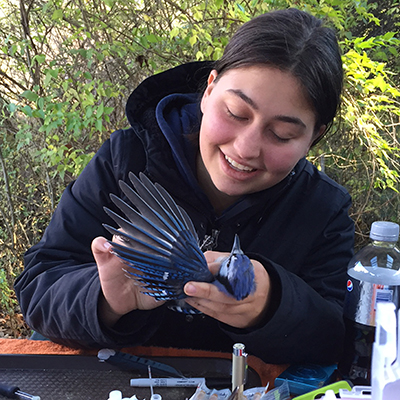
Emily collecting blood from a Blue Jay (Cyanocitta cristata) at the Rushton Woods Preserve bird banding station.
Chyna Poor Thunder
Chyna is an Health Sciences major in the Drexel University College of Nursing and Health Professions and was a STAR (Students Tackling Advanced Research) Scholar in our lab during summer 2017 and continued working in the lab as an intern. She worked on a project aimed at assessing the affects of altitude and habitat type on patterns of prevalence of avian malarial parasites and their relatives (Plasmodium, Haemoproteus, and Leucocytozoon) infecting Nicaraguan birds.
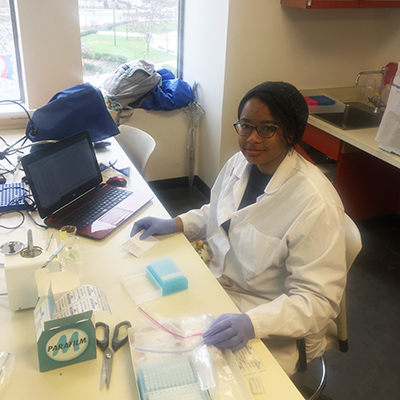
Chyna preparing blood samples for DNA extraction.
Monica Carlson
Monica volunteered at the Academy from January 2016 - August 2017. Monica graduated with a Bachelor of Science in Biology from Duke University and a Master of Arts in Teaching from University of North Carolina Chapel Hill. Over the years she worked in research labs studying plant phylogenetics, birdsong, and primate cognition. As an Ornithology Department volunteer, she assisted with bird specimen collections, VIREO, and research on avian host-parasite coevolution. She is currently a Ph.D. student in the Stoddard lab in the Ecology and Evolutionary Biology Department at Princeton. She is interested in the evolutionary mechanisms underlying the incredible diversity of avian phenotypes.

Jennifer J. Uehling
Jenny was an undergraduate at the University of Chicago, where she volunteered at the Field Museum and graduated with a degree in Biology (concentration: Ecology and Evolution) and Environmental Studies in 2015. A Philadelphia area native, she returned to the city after graduating and started working in the Ornithology Department at the Academy of Natural Sciences in the fall of 2015 as a Delaware Valley Ornithological Club sponsored intern. She learned how to identify avian ectoparasites and worked to organize and upload records of ectoparasites from recent expeditions to ParaSite, an online MySQL application for storing host-parasite biodiversity data. While identifying ectoparasite specimens, Jenny became fascinated with Hippoboscid flies and their host associations. She performed gut dissections and DNA extractions on a set of Hippoboscid flies collected from Mexico and PCR amplified and sequenced DNA from these extracts to barcode the flies, identify their host blood meals, and to screen them for the presence of Haemosporidian blood parasites. She is currently a PhD student in Ecology and Evolutionary Biology at Cornell University.
Jenny holding a fairy wren during her field work in Australia
Kaya Gentile
Kaya is an Environmental Engineering student and was a 2016 STAR (Students Tackling Advanced Research) Scholar in our lab during summer 2016. She worked on a project aimed at estimating the patterns of prevalence of avian malarial parasites and their relatives (Plasmodium, Haemoproteus, and Leucocytozoon) in migratory Saw-whet Owls (Aegolius acadicus). During the summer Kaya screened hundreds of Saw-whet Owl DNA extracts for the DNA of these parasites and sequenced all of the positives. This project was a collaboration with Dr. Glenn Proudfoot at Vassar College.
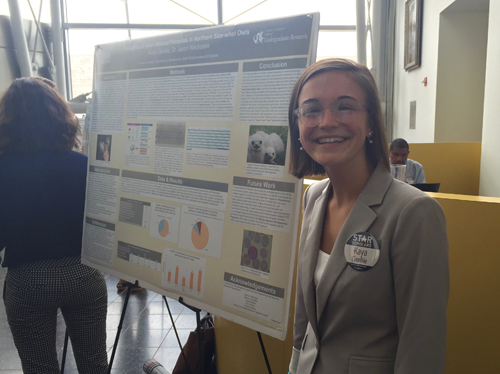
Kaya presenting at the STAR Scholars showcase - Photo by E. N. Ostrow
Ethan Gyllenhaal
Ethan began working with me, at the Field Museum, as a high-school intern in 2013 and returned in summer 2014 after his first year at Rochester University. Ethan worked on on two projects aimed at reconstructing phylogeographic history in two Amazonian bird complexes, the Ivory-billed Araçari (Pteroglossus azara) and Black-spotted Barbet (Capito auratus). Ethan is currently in the Biology Ph.D. program at University of New Mexico, where he is continuing to study the avian evolutionary biology
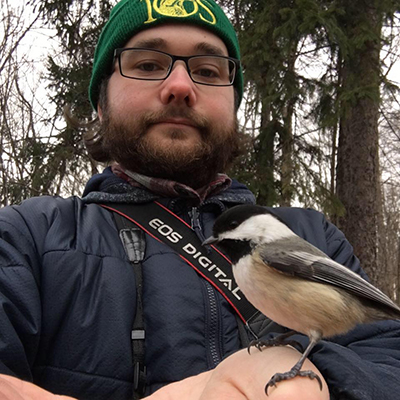
Ethan Gyllenhaal and a Black-capped Chickadee
Nathan Goldberg
Nathan Goldberg was a high-school intern and worked with me on a variety of projects in the lab at the Field Museum. Nathan attended and graduate from Cornell University.

Nathan Goldberg heading out on his first birding Big Day.
Nathan Trautenberg
Nathan Trautenberg was an undergraduate student at the Northwestern University worked as a summer intern sponsored by an REU supplement to our National Science Foundation funded project "Southern Amazonian birds and their symbionts: Biodiversity and endemicity of parasites from the most diverse avifauna on Earth." He collected molecular data to construct a phylogeny of a widespread songbird louse genus Ricinus to examine patterns of host specifity, with the ultimate goal of comparing those patterns to three other genera of songbird associated chewing lice. Nate learned a variety of laboratory skills including collection of ectoparasite specimens, louse identification, slide mounting, DNA extraction, PCR, sequencing, DNA sequence analyses, and phylogenetic methods. Nate gave a talk in the Field Museum's 2012 REU intern symposium. He continued on as a part time as an intern during the school year for several years and is now training to be a school science teacher.
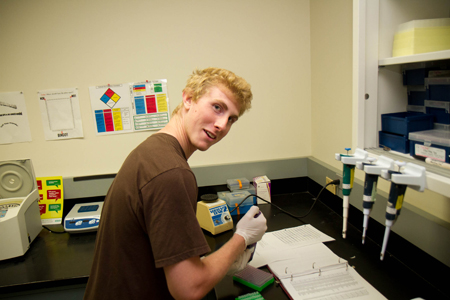
Nathan Trautenberg working the the Prizker Laboratory of Molecular Systematics and Evolution. - Photo by J. D. Weckstein
Jennie Lee
Jennie Lee is an undergraduate Biology student at the University of Chicago and was a summer intern in the Field Museum's 2012 REU summer intern program and worked on a project entitled "Amazonian speciation in a ring: phylogeographic history of the Channel-billed and White-throated toucans." Jennie gave a talk in the Field Museum's 2012 REU intern symposium. She is continuing on part time as an intern during the school year and will use the project that she started to complete a senior thesis at the University of Chicago.
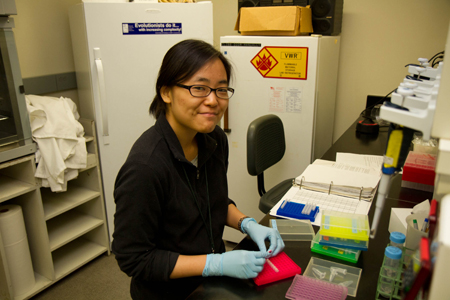
Jennie Lee working the the Prizker Laboratory of Molecular Systematics and Evolution. - Photo by J. D. Weckstein
Ari Rice
Ari Rice was an undergraduate Biology major at Lawrence University in Appleton, Wisconsin. During high school he was a volunteer intern in the Field Museum's bird division. He worked with us as an undergraduate intern on our National Science Foundation funded project "Southern Amazonian birds and their symbionts: Biodiversity and endemicity of parasites from the most diverse avifauna on Earth." He identified and databased avian parasites and also been helped to collect parasites from local birds specimens salvaged in Chicago. He is currently pursuing his Master's degree at Villanova University in Bob Curry's lab and will be collaborating with our lab here at the Academy of Natural Sciences on a study of avian malarial parasites across the Black-capped/Carolina chickadee hybrid zone.
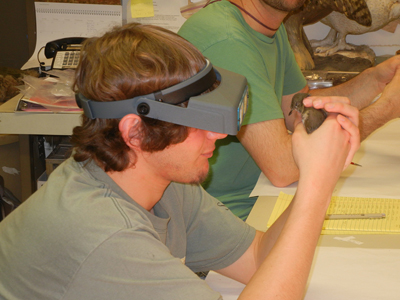
Ari Rice looking at a Catharus thrush that he is about to ruffle for chewing lice. - Photo by J. M. Bates
Joseph Cacioppo
Joe was an undergraduate student at the University of Chicago and worked in our lab at the Field Museum starting in 2009. Joe worked on a variety of projects ranging from a comparative phylogeography project on two lineages of chewing lice (Brueelia and Colpocephalum) from Malagasy couas (Cuculiformes) to several woodcreeper phylogeography projects. Joe's independant project, and the focus of his senior thesis, was aimed at reconstructing the phylogenetic history of Myrsidea, the most diverse chewing louse genus. Myrsidea (Phthiraptera: Amblycera) parasitize toucans, barbets, and most lineages of perching birds. Joe is now in the DVM/Ph.D. program at the University of Illinois Urbana-Champaign. Based on Joe's senior thesis work, we are currently working on a manuscript which aims to assess (1) patterns of host specificity within the genus (Are Myrsidea chewing lice parasitizing the same host families closely related?) and (2) which song bird hosted Myrsidea are closely related to Myrsidea found on toucans (How did toucans aquire their Myrsidea?).
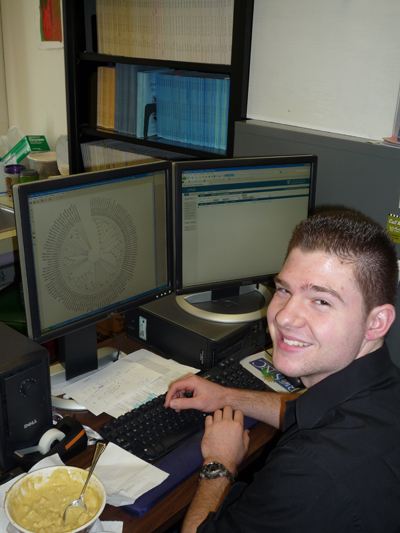
Joe working on a figure for his large phylogeny of the chewing louse genus Myrsidea for his senior thesis. - Photo by J. D. Weckstein
Holly Lutz
Holly was an undergraduate student at the University of Chicago and begain working with me during summer 2008. Holly helped to collect data for various chewing louse population genetics projects. For her independant project she worked on a phylogeny of the lowland toucanets (genus Selenidera) and the mountain toucans (genus Andigena) to test various biogeographic hypotheses and reconstruct the history and timing of speciation in these groups. Holly published this manuscript as a first author. After graduating from U of C, Holly participated in a Field Museum Bird Division expedition to Malawi to study the parasites and pathogens of small birds and mammals and then was hired on to work on the museum's Emerging Pathogens Project. She lead the study of avian blood parasites for that project and in Fall 2011 started in the EEB Ph.D. program at Cornell University, where she has continued to collaborate with us. She graduated from the Cornell Ph.D. program in 2016 and is now an NSF funded postdoctoral researcher at the University of Chicago and The Field Museum. See "Science at FMNH-Can working at The Field Museum change your life?" a video about how Holly's internship at The Field Museum helped her to discover her love for biology.

Holly Lutz cutting bands from an Agarose gel in the Field Museum's Pritzker Lab for Molecular Systematics and Evolution.
Valerie Morley
Valerie was an undergraduate student at Oberlin College and worked with us as an intern during her January 2008 winter term. Valerie conducted a project on the faunistics, seasonality, and prevalence of chewing lice from North American migratory songbirds which we've been collecting in conjunction with Dr. David Willard's long term project on Chicago lake front bird migration. This work involved the identification of louse specimens collected from salvaged migratory birds and quantification of prevalence (number of hosts infected) and intensity (number of parasites on each host) of parasites.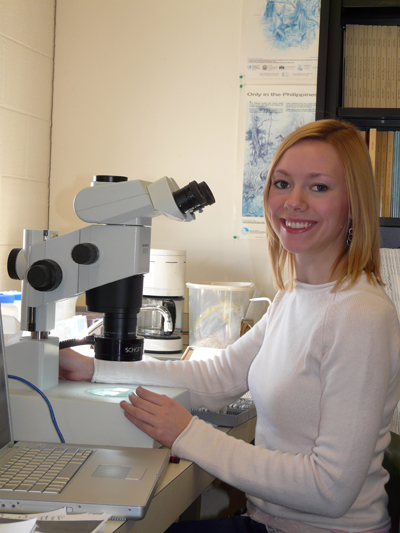
Valerie Morley identifying and counting parasites found on migratory birds from Chicago. - Photo by J. D. Weckstein
Swati Patel
Swati was an undergraduate student at Northwestern University and worked as an intern with us since the end of summer 2007 on several projects aimed at reconstructing the relationships among Amazonian birds, including projects on Hylexetastes and Campylorhamphus woodcreepers. In addition to finishing data collection for the woodcreeper projects Swati worked on an independent project aimed at reconstructing the phylogeny of the araçaris (Pteroglossus), which are small-bodied toucans. This project became her senior thesis project. Swati graduated from Northwestern University in 2009 and won the Emanuel Margoliash Prize in Biological Sciences for her thesis. She is the first author on a paper, based in part on her senior thesis, published in the January 2011 in Molecular Phylogenetics and Evolution. After graduating Swati participated in a Field Museum Bird Division expedition to Malawi to study the parasites and pathogens of small birds and mammals and then she moved to Belem, Brazil where she was a Fulbright Scholar with collaborator, Alexandre Aleixo, at the Museu Paraense Emilio Goeldi. She graduated with a Ph.D. from the applied mathematics program at the University of California, Davis where she studied mathematical models of biology. She is currently a Postdoc at Tulane University in New Orleans, Louisiana.
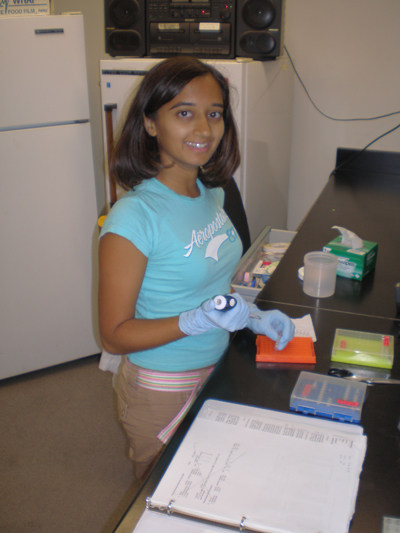
Swati Patel working in the Field Museum's Pritzker Laboratory of Molecular Systematics and Evolution. - Photo by J. D. Weckstein
Irene Swanenberg
Irene is an undergraduate student at Northwestern University and worked with us during summer 2007 on an independent project isolating microsatellite loci and designing primers for two widespread Amazonian species of Ramphastos toucans, R. vitellinus and R. tucanus. Irene successfully designed primers for 18 microsatellite loci for R. tucanus and 10 microsatellite loci for R. vitellinus and she began testing these at the end of the summer. Each of the toucan species that Irene was working with is geographically variable with morphologically distinct subspecies found in different regions of the Amazon and these subspecies are connected to one another by zones of intergradation. These zones of intergradation form hybrid rings across Amazonia for both of these toucan species. Irene designed these microsatellite primers to ultimately study patterns of gene flow across these hybrid zones.
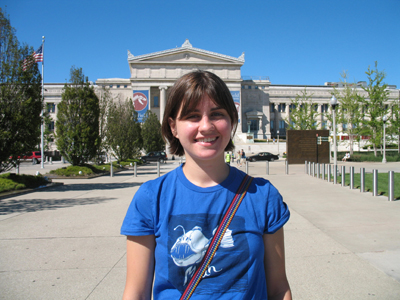
Irene Swanenberg out in front of the Field Museum of Natural History.
Kam Sripada
Kam was an undergraduate student at Brown University and worked with with us as an REU intern during summer 2006, after her first year at Brown. Kam learned skills such as collection of chewing louse specimens, louse identification, slide mounting, DNA extraction, PCR, sequencing, and DNA sequence analyses. She primarily collected phylogenetic and population genetic data for our research on Ramphastos toucans and their Austrophilopterus chewing lice.
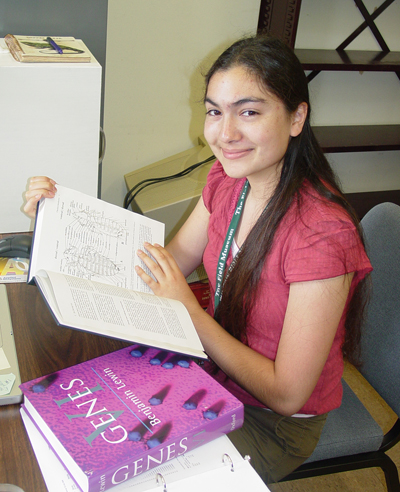
Kam Sripada studying the morphology of chewing lice. - Photo by J. D. Weckstein
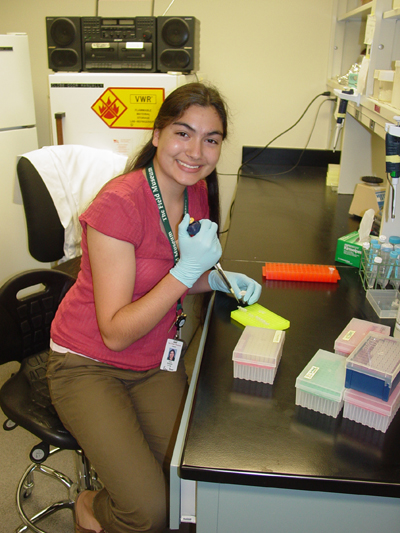
Kam Sripada working in the Field Museum's Prizker Laboratory for Molecular Systematics and Evolution. - Photo by J. D. Weckstein
Chelsea Bueter
Chelsea was an undergraduate student at Lake Forest College interested in studying the evolution of parasitism and disease. Chelsea worked on avian ectoparasites including mites and chewing lice while banding birds as part of Dr. Caleb Gordon's Shaw Woods Avian Monitoring Project. Chelsea worked with us as part of a collaboration between The Field Museum and Dr. Caleb Gordon's Lab at Lake Forest College. Chelsea was an intern with John Bates and myself for over a year and worked on a number of louse population genetics and phylogenetics projects where she learned skills such as collection of louse specimens, louse identification, slide mounting, DNA extraction, PCR, sequencing, and DNA sequence analyses. Chelsea continued on as an intern and collected and analyzed DNA sequence data for her senior thesis, which was on the coevolutionary history of two genera of chewing lice found on Catharus thrushes. She gave a presentation on her senior thesis research at the Seventeenth Annual Argonne Symposium for Undergraduates in Science, Engineering, and Mathematics, which was held in November 2006 at Argonne National Laboratory, Argonne, Illinois. Chelsea successfully defended her senior thesis in April 2007. She is currently in graduate school working on her Ph.D. in virology at the University of Massachusetts. Chelsea is the first author on a paper based in part on her senior thesis, which was published in the April 2009 issue of Journal of Parasitology.
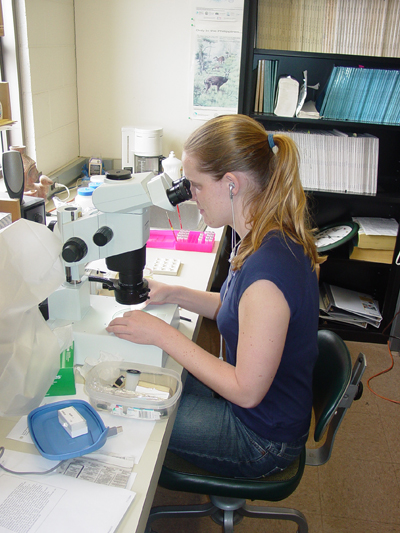
Chelsea Bueter slide mounting chewing louse voucher specimens after extracting their DNA. - Photo by J. D. Weckstein
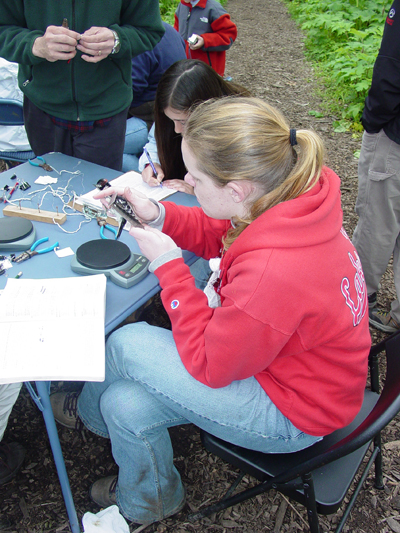
Chelsea Bueter banding a Downy Woodpecker (Picoides pubescens) at the SWAMP field site at Shaw Woods, Lake Forest, illinois. - Photo by J. D. Weckstein